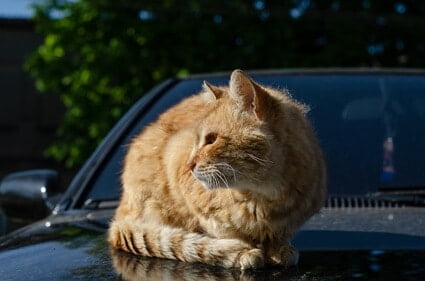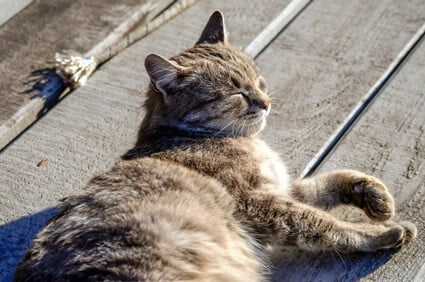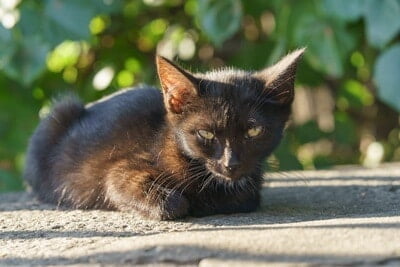Sudden cat fur discoloration will catch your attention. You’ll be used to your cat’s coat being a certain shade, so if it begins to undergo a variation in color, you may be concerned that something is amiss with its health.
Some cats change color due to the temperature so, a cold cat could have darker fur. Cats change color as they age, with younger cats becoming darker and older cats turning gray. UV sun rays bleach dark fur. Also, sudden color changes can signify a hormonal imbalance or tyrosine deficiency.
Don’t assume that sickness is why your cat’s fur is changing color. Familiarize yourself with the varied explanations, as some of them are inconsequential.
Why is My Cat’s Fur Changing Color?
Let’s explore the different reasons why cats’ fur color changes:
Fever Coat
Fever coat is a condition that impacts kittens, not adult cats.
It happens when the mother experiences stress or respiratory illness while pregnant. If this occurs, the litter will be born with unique pattern markings.
The kittens may have unusual fur shade combinations or a block color rarely associated with their breeds, such as silver or cream. This will be notable in breeds like the Siamese, which are normally born with white fur.
Fever coat isn’t harmful to kittens and doesn’t last long. After a few weeks, the coat reaches its natural shade. From this point, it shouldn’t change any further.
Sunlight
Dark-haired humans find that the sun bleaches and lightens their hair. If your cat is a sun-worshipper, its fur will change shade due to prolonged sun exposure. This is most noticeable in black cats, who will turn a rusty color.
This is due to melanin, which is found organically in a cat’s body. It’s a genetic inheritance from a cat’s parentage. Eumelanin provides black or dark brown fur, while pheomelanin creates red and orange shades.
Melanin isn’t purely aesthetic as it also protects a cat’s delicate skin from being burned by the sun. Unfortunately, UV rays destroy melanin, causing a cat’s fur shade to lighten.
A cat’s body is constantly replacing melanin, which means its fur will eventually return to its normal shade. Usually, it’ll need to undergo a shedding cycle for this to happen.
A cat’s fur lightening isn’t a concern, but it suggests that your cat is spending too much time in the sun.
Tyrosine Deficiency
A dark cat that steadily turns lighter may be experiencing a nutritional deficiency. Usually, this relates to tyrosine, which is considered a non-essential amino acid because it’s created within the feline body.
Cats need twice as much tyrosine as their bodies can produce. According to the Journal of Small Animal Practice, the average cat needs over 5g of tyrosine daily.
Tyrosine is related to melanin production, and a lack of it will bleach a cat’s fur. If your cat doesn’t spend time in the sun, a tyrosine deficiency will likely explain the color change.
Tyrosine must feature in your cat’s diet, but any reputable, well-balanced cat food will contain this amino acid.
Vitiligo
Vitiligo is rare in felines, but it can sometimes arise.
Vitiligo is a condition that causes the skin to lose pigmentation, resulting in white spots and patches around the cat’s body. Any hair that surrounds this skin will also lose coloring.
Focal vitiligo will be concentrated on one part of your cat’s skin, such as the nose leather. As cats have little hair in this area, the fur color is unlikely to be affected.
Generalized vitiligo will cause random, cobweb-like patches throughout the skin and fur. Vitiligo usually starts small and spreads. You’ll notice increasing changes to your cat’s fur color over the months and years.
As explained by Experimental Biology and Medicine, vitiligo is an autoimmune disease. There’s no cure for the condition, but it doesn’t cause any pain and discomfort.

Post-Surgery
If your cat has recently undergone surgery, its fur will likely have been shaved to give the vet better access to an area that requires medical attention. The aftermath of this is that you may notice a change in fur color.
Your cat’s hormones react to the operation and anesthetic, leading to a temporary change in fur hue. Before long, your cat will return to its normal fur color.
Your cat may be regrowing hair ahead of a shedding cycle. This will be a different shade to what grows during the fall, but your cat’s new coat will eventually catch up and match.
Skin Temperature
Some cat breeds are genetically prone to fur color changes, such as pointed breeds. This means that the cat’s body temperature lowers as its skin darkens.
This table summarizes cat breeds that regularly change color and the reason why it happens:
| Cat Breed | Reason for Fur Color Change |
|---|---|
| Balinese: | Skin temperature |
| Birman: | Skin temperature |
| British Shorthair: | Skin temperature |
| Chinchilla: | Only outer, thicker fur is colored – different shades may appear after shedding. |
| Highlander: | Skin temperature |
| Himalayan: | Skin temperature |
| Javanese: | Skin temperature |
| Napoleon: | Skin temperature |
| Oriental: | Skin temperature |
| Persian: | Often born white, but transition into a wide array of colors |
| Peterbald: | Skin temperature |
| Ragdoll: | Skin temperature |
| Siamese: | Born white and darkens with age; fur color fluctuates depending on skin temperature. |
| Siberian: | Skin temperature |
| Tonkinese: | Skin temperature |
If your cat’s breed isn’t listed, there will be another explanation.
Fur Color Changes And What They Mean
Note what color your cat’s fur should be compared to the variation in hue:
Fur Turning Gray in Cats
Is your black cat turning white? If your cat is older than 10, it’s natural as cats start to gray as they age because the body produces less melanin as it grows older.
Gray hairs will first appear around the muzzle and may spread from there. Gray fur is much more noticeable in darker-colored cats than lighter-colored cats.
Graying fur isn’t a sign of imminent demise as cats live longer as seniors than they do at any life stage. Gray fur can suggest that other ailments are likely to become a problem in the future, such as wobbly back legs.
Black Fur Turning Brown in Cats
Black fur fading to brown is the first step toward eventual graying. A cat’s fur is unlikely to go straight from black to white, as there’s a slow fading process.
If your cat seems too young to be going gray, check for other behaviors. If your cat is acting out of sorts, it may have an organ problem, such as chronic renal failure.
Also, monitor how much time your cat spends in the sun’s UV rays.
Black Fur Turning Red in Cats
Black fur turning a rusty shade of red has these explanations.
- Melanin production is slowing down with age
- Fur has been bleached in the sun
- Cat has a tyrosine deficiency
If your cat is growing older, this is natural and irreversible. If it’s being bleached by the sun, the cat may be experiencing excessive UV exposure. A tyrosine deficiency can be managed through diet or supplementation.
Brown Fur Turning Black in Cats
Brown fur darkening to black is a symptom of excessive tyrosine.
Ensure that your cat is getting the correct quantities of this amino acid, as striking the right balance of vitamins and minerals is important to a cat’s health.
This change can be due to excessive protein. As per Veterinary Clinics: Small Animal Practice, older cats still need protein, but it needs to ingest the right amount.
Light Fur Turning Brown in Cats
Lighter-colored adult cats rarely become darker with any permanence. A cat with white or light brown fur will lack the appropriate pigmentation to darken sufficiently.
If your cat has pointed coloration, the fur darkens when the ambient temperature drops because the skin darkens.
Your cat may have stained its fur, especially if it roams outdoors. For example, your cat’s fur could even be stained with feces from the litter tray.
Can a Cat’s Fur Pattern Change?
A cat’s fur can change color, but its pattern won’t alter. A spotted cat will always be spotted, and a stripy cat will always have stripes.
My Cat’s Fur Changed Color Suddenly
If your cat’s fur has changed color seemingly overnight, there could be a medical explanation:
Stress and Physical Pain
Applied Animal Behavior Science stated that stress could turn canine fur gray. However, it has never been proven that this also applies to cats, but it’s possible.
Premature graying hair is linked to heightened levels of the hormone noradrenaline (norepinephrine). A cat’s body constantly releases noradrenaline in small doses, which is normal. It differs from adrenaline (epinephrine).
Noradrenaline is connected to the nervous system and, during times of intense stress or pain, it floods the body. As per the Journal of Physiology, this occurs in felines, suggesting that the fur of a cat in pain or stress can quickly turn gray.
Graying fur isn’t necessarily a sign of stress or ill health, especially in older cats.
Look out for these warning signs:
- Hiding and reluctance to interact
- Excessive verbalization
- Uncharacteristic displays of aggression
- Restlessness
- Lethargy and depression
- Lack of interest in grooming or play

Hypothyroidism
Hypothyroidism is the result of an underactive thyroid gland. This gland releases triiodothyronine (T3) and thyroxine (T4), which are essential for a cat’s body and organs to function.
If the cat’s thyroid gland is underactive, it won’t receive enough T3 or T4, causing the following symptoms:
- Constant lethargy and exhaustion
- Weight gain
- Excessive thirst
- Low body temperature (below 100 degrees Fahrenheit)
- Lack of grooming
- Lack of interest in play or activity
More pertinently, a hypothyroid cat will have a dull, listless coat.
Jaundice (Icterus)
Jaundice is a skin condition that will cause your cat’s skin to develop a yellow hue. This will be most noticeable in light-colored cats, where the fur will start to look dirty and discolored.
Jaundice is harder to spot in dark-furred cats. If your cat’s eyes are dull and yellow and the gums are pale and faded, jaundice is a possibility.
Other common symptoms include:
- Loss of appetite
- Sudden weight loss
- Vomiting and diarrhea
- Chronic dehydration
- Blood in the urine or feces
- Lethargy and depression
Cushing’s Disease (Hyperadrenocorticism)
Cushing’s disease will generate excessive cortisol (stress hormone). This ailment differs from stress caused by generalized anxiety or physical pain, but the impact on fur can be similar.
The symptoms of Cushing’s disease include the following:
- Excessive thirst and urination
- Excessive hunger
- Shortness of breath
- Lethargy and depression
- Bloated or distended abdomen
- Weak, damaged skin
The cause of Cushing’s disease will be a tumor, which will be located on the brain’s pituitary gland. This is found on the base of the brain, so an MRI will be required.
The tumor must be surgically removed. Molecular and Cellular Endocrinology describes this as a safe and effective treatment. In some cases, radiotherapy or chemotherapy may be required.
Cat fur changes color all the time. This is a natural phenomenon in most instances, but health conditions can sometimes be responsible. If so, your cat’s likely to show other physical symptoms.


I have a ginger cat. We went through hurricane Ian. Our house was destroyed. We we’re here. The workmen are here frequently. Our cat now has white spots The skin is healthy it looks white not grey. Is this a medical problem?
My cat is an orange tabby male and is now growing black hairs.Is this something I need to worry about? Nothing major has happened and he is three years old.